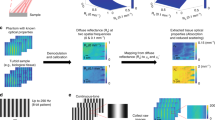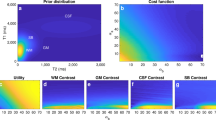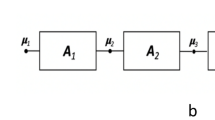Abstract
Objective: Nonlinear feedback interactions induced by the spins themselves have recently been introduced as novel MRI contrast enhancement mechanisms sensitive to small differences in MR parameters. Developing feedback-based contrast enhancement into a useful tool for in vivo imaging requires improved techniques that are robust to inhomogeneity and sensitive to subtle anatomical/physiological variations.
Materials and methods: Three different imaging methods combining the radiation damping feedback field with the distant dipolar field, applied radio-frequency (RF) fields, and local dipole fields, respectively, were designed and tested through numerical simulations on simple phantoms. These methods were demonstrated experimentally on live guppy fish, developing frog embryos, and blood in in vitro tissue samples by microimaging at 14.1 T.
Results: The developed feedback-based methods yielded images that identified distinct morphological features with superior contrast compared with conventional MR images and those acquired under radiation damping only. Positive contrast due to evolution under radiation damping and local dipole fields was also observed in SPIOs and blood.
Conclusion: Approaches to enhancing feedback-based contrast were successfully designed and demonstrated in vitro and in vivo. The newly devised methods were less sensitive to field inhomogeneity and prolonged evolution under the feedback fields, allowing for better visualization of contrast in vivo.
Similar content being viewed by others
References
Datta S, Huang SY, Lin YY (2006) Contrast enhancement by feedback fields in magnetic resonance imaging. J Phys Chem B 110:22071–22078
Huang SY, Wolahan SM, Mathern GW, Chute DJ, Akhtari M, Nguyen ST, Huynh M, Salamon N, Lin YY (2006) Improving MRI differentiation of gray and white matter in epileptogenic lesions based on nonlinear feedback. Magn Reson Med 56:776–786
Bulte JWM, Kraitchman DL (2004) Iron oxide MR contrast agents for molecular and cellular imaging. NMR Biomed 17:484–499
Haacke EM, Brown RW, Thompson MR, Venkatesan R (1999) Magnetic resonance imaging: physical principles and sequence design. Wiley, New York
Bloembergen N, Pound RV (1954) Radiation damping in magnetic resonance experiments. Phys Rev 95:8–12
Black RD, Early TA, Roemer PB, Mueller OM, Mogrocampero A, Turner LG, Johnson GA (1993) A high-temperature superconducting receiver for nuclear-magnetic-resonance microscopy. Science 259:793–795
Darrasse L, Ginefri JC (2003) Perspectives with cryogenic RF probes in biomedical MRI. Biochimie 85:915–937
Ginefri JC, Poirier-Quinot M, Robert P, Darrasse L (2005) Contrast-enhanced dynamic MRI protocol with improved spatial and time resolution for in vivo microimaging of the mouse with a 1.5-T body scanner and a superconducting surface coil. Magn Reson Imaging 23:239–243
Wright AC, Song HK, Wehrli FW (2000) In vivo MR micro imaging with conventional radiofrequency coils cooled to 77 degrees K. Magn Reson Med 43:163–169
Ma QY, Chan KC, Kacher DF, Gao EZ, Chow MS, Wong KK, Xu H, Yang ES, Young GS, Miller JR, Jolesz FA (2003) Superconducting RF coils for clinical MR imaging at low field. Acad Radiol 10:978–987
Bloom S (1957) Effects of radiation damping on spin dynamics. J Appl Phys 28:800–805
Broekaert P, Jeener J (1995) Suppression of radiation damping in NMR in liquids by active electronic feedback. J Magn Reson A 113:60–64
Abergel D, Louis-Joseph A, Lallemand JY (1996) Amplification of radiation damping in a 600-MHz NMR spectrometer: application to the study of water-protein interactions. J Biomol NMR 8:15–22
Lin YY, Huang SY (2006) Method and system for the amplification of nuclear magnetic resonance imaging. UC Case No. 2006-328-1
Khokha MK et al (2002) Techniques and probes for the study of Xenopus tropicalis development. Dev Dyn 225:499–510
Huang SY, Anklin C, Walls JD, Lin YY (2004) Sizable concentration-dependent frequency shifts in solution NMR using sensitive probes. J Am Chem Soc 126:15936–15937
Deville G, Bernier M, Delrieux JM (1979) NMR multiple echoes observed in solid He-3. Phys Rev B 19:5666–5688
Warren WS, Richter W, Andreotti AH, Farmer BT (1993) Generation of impossible cross-peaks between bulk water and biomolecules in solution NMR. Science 262:2005–2009
Warren WS, Ahn S, Mescher M, Garwood M, Ugurbil K, Richter W, Rizi RR, Hopkins J, Leigh JS (1998) MR imaging contrast enhancement based on intermolecular zero quantum coherences. Science 281:247–251
Zhong JH, Chen Z, Kwok E (2000) In vivo intermolecular double-quantum imaging on a clinical 1.5 T MR scanner. Magn Reson Med 43:335–341
Enss T, Ahn S, Warren WS (1998) Visualizing the dipolar field in solution NMR and MR imaging: three-dimensional structure simulations. Chem Phys Lett 305:101–108
Ferreira HA, Graham DL, Freitas PP, Cabral JM (2003) Biodetection using magnetically labeled biomolecules and arrays of spin valve sensors. J Appl Phys 93:7281–7286
Lin YY, Lisitza N, Ahn S, Warren WS (2000) Resurrection of crushed magnetization and chaotic dynamics in solution NMR spectroscopy. Science 290:118–121
Warren WS, Hammes SL, Bates JL (1989) Dynamics of radiation damping in nuclear magnetic resonance. J Chem Phys 91:5895–5904
Chen JH, Jerschow A, Bodenhausen G (1999) Compensation of radiation damping during selective pulses in NMR spectroscopyCompensation of radiation damping during selective pulses in NMR spectroscopy. Chem Phys Lett 308:397–402
Seppenwoolde JH, Viergever MA, Bakker CJG (2003) Passive tracking exploiting local signal conservation: the white marker phenomenon. Magn Reson Med 50:784–790
Faber C, Heil C, Zahneisen B, Balla DZ, Bowtell R (2006) Sensitivity to local dipole fields in the CRAZED experiment: an approach to bright spot MRI. J Magn Reson 182:315–324
Cunningham CH, Arai T, Yang PC, McConnell MV, Pauly JM, Conolly SM (2005) Positive contrast magnetic resonance imaging of cells labeled with magnetic nanoparticles. Magn Reson Med 53:999–1005
Tyszka JM, Fraser SE, Jacobs RE (2005) Magnetic resonance microscopy: recent advances and applications. Curr Opin Biotechnol 16:93–99
Jacobs RE, Fraser SE (1994) Magnetic resonance microscopy of embryonic cell lineages and movements. Science 263:681–684
Dhenain M, Ruffins SW, Jacobs RE (2001) 3D time-lapse analysis of Xenopus gastrulation movements using mu MRI. Dev Biol 232:458–470
Johnson GA, Cofer GP, Gewalt SL, Hedlund LW (2002) Morphologic phenotyping with MR microscopy: the visible mouse. Radiology 222:789–793
Blackband SJ, Stoskopf MK (1990) In vivo nuclear magnetic resonance imaging and spectroscopy of aquatic organisms. Magn Reson Imaging 8:191–198
Van der Linden A, Verhoye M, Pörtner HO, Bock C (2004) The strengths of in vivo magnetic resonance imaging (MRI) to study environmental adaptational physiology in fish. Magn Reson Mater Phys 17:236–248
Author information
Authors and Affiliations
Corresponding author
Rights and permissions
About this article
Cite this article
Huang, S.Y., Furuyama, J.K. & Lin, YY. Designing feedback-based contrast enhancement for in vivo imaging. Magn Reson Mater Phy 19, 333–346 (2006). https://doi.org/10.1007/s10334-006-0061-z
Received:
Revised:
Accepted:
Published:
Issue Date:
DOI: https://doi.org/10.1007/s10334-006-0061-z




